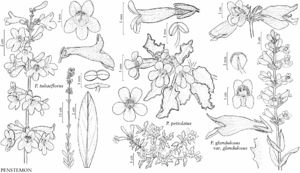Penstemon petiolatus
Bot. Gaz. 27: 455. 1899.
Stems 5–25(–40) cm. Leaves: cauline 2–4 pairs, 14–30(–35) × 6–17 mm, base tapered to cuneate, margins dentate to serrate-dentate, apex obtuse to acute. Thyrses 3–6 cm, verticillasters 2–6, cymes 1–3(–5)-flowered; proximal bracts ovate to lanceolate, 6–25 × 2–14 mm; peduncles and pedicels puberulent and sparsely glandular-pubescent, especially distally. Flowers: calyx lobes lanceolate, 4.5–6 × 1.2–1.9(–2.1) mm; corolla with violet nectar guides, 13–17 mm, sparsely glandular-pubescent externally, sparsely whitish or yellowish villous internally abaxially, tube 5–6 mm, throat 4–5 mm diam.; stamens: pollen sacs 0.5–0.9 mm; staminode 10–11 mm; style 9–13 mm. Capsules 5–7 × 4–5 mm.
Phenology: Flowering May–Jun.
Habitat: Crevices in limestone outcrops, desert shrub communities, juniper woodlands.
Elevation: 1000–1700 m.
Distribution
Ariz., Nev., Utah.
Discussion
Penstemon petiolatus occurs in the Beaver Dam and Virgin mountains in northwestern Mohave County, Arizona, the Charleston Mountains and Sheep Range in Clark County, Nevada, and the Beaver Dam Mountains in southwestern Washington County, Utah. Penstemon calcareus M. E. Jones is an illegitimate, later homonym that applies here.
Selected References
None.
